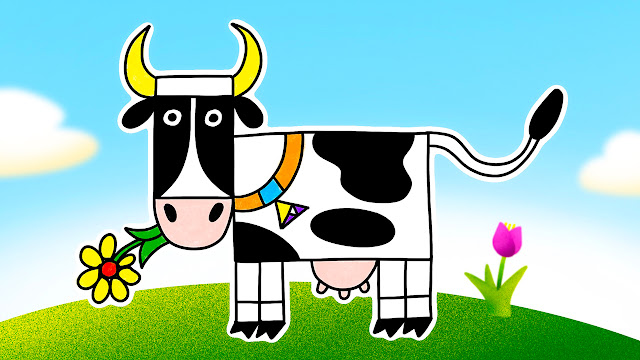 |
| Click on this picture to watch the video and follow along! |
Lesson Title: Exploring Farm Animals
Grade Level: Kindergarten Duration: 1 hour
COW
Objectives:
1. Students will identify and name common farm animals. Students will describe the sounds, physical characteristics, and roles of farm animals.
2. Students will learn and identify the elements and principles of design (line, shape, color and proportion).
3. Students will create an artwork of a cow using the elements and principles of design (line, shape, color and proportion) with basic geometric shapes, such as circles, triangles, rectangles, and squares.
3. Students will create an artwork of a cow using the elements and principles of design (line, shape, color and proportion) with basic geometric shapes, such as circles, triangles, rectangles, and squares.
Materials:
1. Pictures or flashcards of farm animals (cow, pig, chicken, sheep, horse, etc.).
2. Art supplies (crayons, markers, colored pencils, scissors, glue, construction paper).
3. Large poster paper or a whiteboard.
4. Storybook about farm animals (e.g., "Big Red Barn" by Margaret Wise Brown).
Introduction (15 minutes):
1. Begin by discussing with the students what they know about farms and farm animals.
2. Show pictures or flashcards of various farm animals and ask students to name them. Introduce the concept of farms and explain that farms are places where these animals live and where we get some of our food.
GET INSPIRED!
Art is always inspiring. Look for inspiration in this artwork and get to know the artist too.

Written by Thornton W. Burguess, illustrated by Harrison Cady, (1877-1970), American illustrator and author, best known for his Peter Rabbit comic strip which he wrote and drew for 28 years.
You can get to learn a lot just by looking at an artist artwork. Here's a very easy guide to assist you in the process of learning while enjoying the artist's work.
ART APPRECIATION: THE FELDMAN'S MODEL OF ART CRITICISM
1. DESCRIPTION: Describe what you see. What is the artwork depicted all about?
2. ANALYSIS: Elements and Principles of Design. How does the artist uses them all
3. INTERPRETATION: What is the content or meaning? What does it mean to you?
4. JUDGMENT: How original is the work? Do you like it? Why?
2. ANALYSIS: Elements and Principles of Design. How does the artist uses them all
3. INTERPRETATION: What is the content or meaning? What does it mean to you?
4. JUDGMENT: How original is the work? Do you like it? Why?
VOCABULARY WORDS
- farm animals
- geometric shapes
- circle
- oval
- triangle
- rectangle
- square
- line
- color
- shape
- proportion
Activity 1: Farm Animal Sounds (15 minutes):
1. Show pictures or flashcards of farm animals and ask students to imitate the sounds each animal makes.
2. Discuss the sounds they make, e.g., "Cows say 'moo,' pigs say 'oink,' chickens say 'cluck,'" etc.
3. Have a fun activity where you play the sounds of these animals and have the children guess which animal it is.
Activity 2: Farm Animal Art (20 minutes):
Watch this Video »
Give each student a piece of construction paper and markers, crayons, or colored pencils.
Ask the students to look at the image of a cow and image drawing it with geometric shapes.
Choose a simple animal (e.g., a fish, bird, cat, or dog) as an example to demonstrate the process.
Guide the students through the steps of creating their geometric animal:
a. Start with a large shape for the body (e.g., a rectangle).
b. Add smaller shapes for the head, eyes, ears, nose, and tail using triangles, circles, and rectangles.
c. Encourage them to be creative in combining shapes to resemble the cow.
ELEMENTS & PRINCIPLES OF DESIGN
Elements: Line, Shape, Space, Color, Form, Texture, Value. Principles: Balance, Unity, Variety, Emphasis, Movement, Pattern, Proportion.
Briefly talk about the Elements and Principles of Design and mention line, shape, color and proportion as the ones that we will use for this lesson.
Proportion:
Proportion means making sure that the different parts of your artwork, like the head, body, arms, and legs, are the right size compared to each other. So, in this example, you'd want to make sure the head is the right size compared to the body, and the arms and legs are the right length.
Activity 3: Farm Animal Story (10 minutes):
1. Read a farm animal-themed storybook, such as "Big Red Barn" by Margaret Wise Brown.
2. Pause during the reading to ask questions about the story and the farm animals featured in it.
3. Discuss the roles of these animals on the farm and how they help provide us with food.
Conclusion (5 minutes):
1. Have each student share their geometric cow artwork with the class, explaining which animal they chose and how they used geometric shapes to create it.
2. Discuss as a class how geometric shapes can be used to make various objects and animals in art.
Assessment:
Assessment for this lesson can be based on the student's ability to use basic geometric shapes to create a recognizable cow, their creativity in combining shapes, and their use of color and details in their artwork.
Extension Activity (Optional):
Students can create a larger collaborative mural by combining their geometric animal drawings to make a "Geometric Zoo" display in the classroom. This can be a fun way to showcase their artwork and reinforce the concept of shapes in a collective project.
